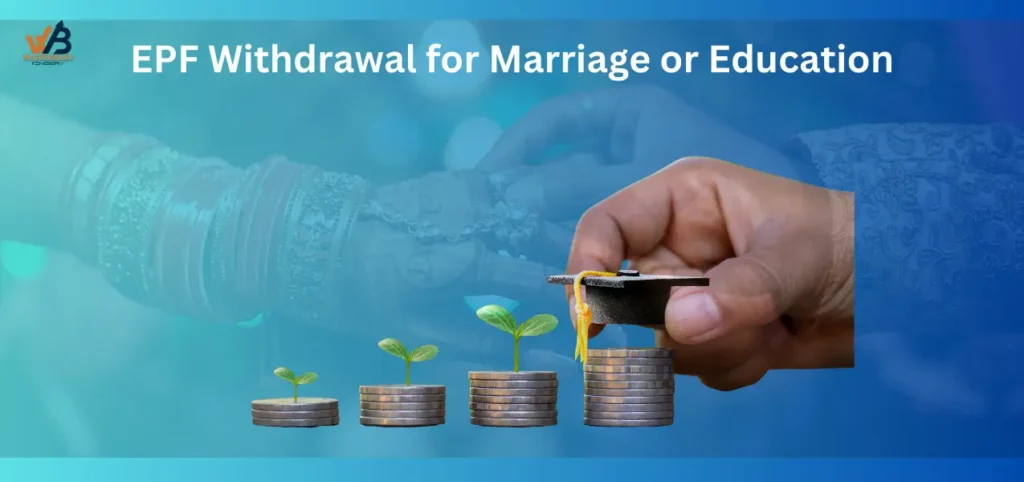
A Complete Guide to EPF Withdrawal Rule (2025 Edition)
“EPF is meant for your future—so take out money only when truly needed.”
Introduction
The Employees’ Provident Fund (EPF) is more than just a retirement saving tool — it’s a vital financial cushion that can support your goals like buying a house, funding a child’s education, or managing medical emergencies.
While the EPF helps accumulate wealth for retirement, it also offers flexibility in partial and full withdrawals.
However, most people are not fully aware of the detailed rules — especially around taxation, home loan repayments, or post-retirement holding periods.
This blog breaks down the latest EPF withdrawal rules for 2025 in simple terms, covering everything you need to know.
Basic EPF Withdrawal Rules 2025
1. Eligibility
-
EPF is mandatory for employees earning up to ₹15,000/month in establishments with 20 or more employees.
-
Both employee and employer contribute 12% of the employee’s basic salary + dearness allowance to the EPF account.
2. UAN (Univers
al Account Number)
-
Every EPF member is allotted a UAN which remains the same throughout their employment.
-
UAN must be linked with Aadhaar, PAN, and bank account for smooth transactions.
3. EPF Contribution Breakdown
-
Employee’s Contribution: 12% of salary.
-
Employer’s Contribution: 12% of salary (8.33% to EPS – Employee Pension Scheme, and 3.67% to EPF).
4. Interest Rate
-
EPF balance earns interest as declared annually by the EPFO. For FY 2024-25, the rate was 8.25%, and similar rates are expected in 2025-26.
5. Tax Benefits
-
EPF contributions are eligible for deduction under Section 80C.
-
Interest and maturity amounts are tax-free only if the employee completes 5 years of continuous service.
6. Withdrawal Rules
-
Full withdrawal allowed:
-
After retirement.
-
After 2 months of continuous unemployment.
-
-
Partial withdrawal permitted for:
-
Medical emergencies.
-
Marriage or education.
-
Home purchase, renovation, or loan repayment.
-
Pre-retirement (after age 54) – up to 90% of the balance.
-
7. Online Services
-
EPFO portal and UMANG app offer online services like balance check, passbook view, claim status, and withdrawal applications.
8. Account Transfer
-
EPF account is portable and can be transferred online when changing jobs, using the same UAN.
Source:EPFO Official Website
When & How You Can Access Your Provident Fund
Your Provident Fund (PF) is designed as a long-term financial cushion for your retirement years. However, life is unpredictable—and in recognition of this, the EPF withdrawal rule have provisions that allow access to funds under certain non-retirement circumstances.
Broadly, there are three ways to withdraw money from your EPF account:
- Final PF Settlement – Full withdrawal upon retirement or after two months of continuous unemployment.
- Partial PF Withdrawal – For specific needs such as home purchase, medical emergencies, or education.
3.Pension Withdrawal Benefit – Withdraw the pension amount if you don’t meet eligibility for monthly pension.
“Think of EPF as your future’s fuel—don’t burn it for today’s spark.”
How to make sure your EPF withdrawal doesn't get rejected
To avoid the rejection of your EPF (Employees’ Provident Fund) withdrawal claim, it’s crucial to ensure accuracy and compliance with the EPFO’s requirements. Here are the key steps to take:
1. Link Aadhaar with UAN and Verify
- Ensure your Aadhaar is linked with your UAN (Universal Account Number).
- Your name, date of birth, and gender should match across Aadhaar, PAN, and EPFO records.
- Use the EPFO portal to verify KYC details.
2. Complete KYC Details
Update and verify:
- Aadhaar
- PAN (especially important if claiming before 5 years of service)
- Bank Account Details (with correct IFSC)
- All documents must be approved by the employer and shown as “Verified” on the portal.
3. Correct Exit Date Entry
- Ensure that your employer has updated your date of exit from the company.
- You can check it under “View > Service History” on the EPFO portal.
4. Use the Right Form and Reason for Withdrawal
Use:
- Form 19 for final settlement
- Form 10C for pension withdrawal
- Form 31 for partial withdrawals (medical, marriage, home loan, etc.)
Select the correct reason and supporting documents if needed.
5. Ensure No Multiple UANs
- If you have worked at multiple organizations, make sure to consolidate UANs if more than one was generated.
- Use the ‘One Member – One EPF Account’ facility.
6. Signature Mismatch or Bank Details Error
- Your name and signature should match across all submitted documents.
- Double-check your bank account number and IFSC code.
7. File the Claim Through Proper Channel
File the claim:
- Online through EPFO portal (preferred)
- Or offline via employer (if digital not possible)
- Ensure your mobile number is linked to Aadhaar for OTP verification.
8. Check Eligibility Before Filing
- Fulfill minimum service requirements for specific claims (e.g., 5 years for some withdrawals).
- Ensure sufficient balance is available in your account.
9. Avoid Multiple Simultaneous Claims
- Don’t submit multiple claims at once — it often leads to rejection.
10. Track Status and Respond to Issues
- Use the EPFO portal to track claim status.
- If rejected, note the reason stated and refile after correcting the error.
EPF Withdrawal Rule for Home Loan Repayment (Partial or Full Closure)

You can use your EPF balance to repay a home loan, either partially or in full. Here’s how:
Eligibility Criteria:
- Minimum 5 years of EPF membership is required.
- The property must be registered in your name, your spouse’s name, or jointly.
- The purpose must be clearly mentioned — repayment of home loan principal or interest.
Withdrawal Limit:
- You can withdraw up to 90% of your EPF balance, including both employee and employer contributions with interest.
Required Documents:
- Form 31 (EPF advance claim form).
- Declaration form stating the loan repayment purpose.
- Details of your home loan:
- Loan account number
- Bank or financial institution name
- Outstanding amount
- Loan repayment schedule or a copy of your passbook.
Application Methods:
- Online via the UAN Member Portal.
- Offline through your employer.
Note: The withdrawn amount will be credited directly to the lender, not to your personal bank account.
EPF Withdrawal Rule for Marriage or Education

Eligibility:
- Minimum 7 years of EPF membership.
Withdrawal Limit:
- Up to 50% of the employee’s share, including interest.
Frequency:
- Maximum of 3 times in a lifetime (combined for marriage and education).
Who Is Covered?
- Marriage: Self, sibling, or children.
- Education: For children pursuing higher education.
Processing Time:
- Online: 3–4 working days
- Offline: Up to 20 working days
EPF Withdrawal for Medical Emergencies

Eligibility:
- No minimum service period is required.
Withdrawal Limit:
You can withdraw the lowest of the following:
- 6 months’ basic salary + Dearness Allowance (DA)
- EPF balance available
- Amount claimed
Frequency:
- Can be claimed multiple times, as needed.
Processing Time:
- Online claims under ₹1 lakh are usually auto-approved within 7–10 days.
Additional Notes:
- Can be claimed for self or dependents.
- No bills required for online claims below ₹1 lakh.
EPF Withdrawal Rule After Retirement

Rules for Full Withdrawal:
- You can withdraw 100% of your EPF once you retire or remain unemployed for 2 months.
- If you continue working after 58 years, EPF contributions go to the Employees’ Pension Scheme (EPS) instead.
- After retirement, you can choose to keep the EPF account active and let it earn interest.
How Long Can You Hold EPF After Retirement?
- Your EPF account will remain active and interest-bearing for 3 years from the last contribution.
- After that, it becomes inoperative, and no interest is paid.
- However, you can still withdraw the balance at any time — the principal is safe.
Tax Rules on EPF Withdrawals
-
Withdrawals After Retirement:
- 100% tax-free, if withdrawn after retirement and after 5 years of service.
Withdrawals Before 5 Years of Service:
- Subject to TDS (Tax Deducted at Source):
- 10% TDS if PAN is linked.
- 30% TDS if PAN is not linked.
- No TDS if the total amount is less than ₹50,000.
Post-Retirement Interest:
- While your EPF balance earns interest for 3 years post-retirement, this interest is taxable under ‘Income from Other Sources’.
To make the most of your retirement corpus, consider reallocating EPF funds to other tax-efficient instruments with the help of our retirement planning services
Should You Withdraw or Keep Your EPF?
Here’s a quick decision guide:

How to Withdraw EPF: Step-by-Step Guide
Online Process:
- Visit the EPFO Member Portal.
- Log in using your UAN and password.
- Click on ‘Online Services’ > ‘Claim (Form-31, 19, 10C & 10D)’.
- Verify your KYC details.
- Choose the reason for withdrawal (e.g., marriage, home loan, etc.).
- Upload any required documents and submit You may need to upload a scanned copy of a canceled cheque for verification
Offline Process:
- Download Form 31 or other relevant forms.
- Fill in the form manually.
- Submit it to your employer or nearest EPFO regional office with documents.
- Processing may take up to 20 days.
Conclusion
The Employees’ Provident Fund offers both security and flexibility. Whether you’re planning to buy a home, cover a medical emergency, or preparing for retirement, knowing the EPF rules helps you make smart and tax-efficient choices.
By understanding the withdrawal process, eligibility, limits, and tax implications, you can use your EPF savings wisely and avoid unnecessary penalties or delays.
Need Help With EPF or Retirement Planning?
Let the experts at WealthBeats Finserv help you!
We offer customized retirement planning, home loan advisory, and tax-efficient EPF strategies for working professionals and retirees.
Call on – 9625565403
FAQ
- Your EPF claim may be rejected due to:
- Wrong or unverified KYC (Aadhaar, PAN, bank details)
- Exit date not updated by employer
- Signature or document mismatch
- Incorrect or inactive bank account
- PAN not linked (especially if withdrawing before 5 years)
- Technical issues or multiple claims filed
- Log in to EPFO Member Portal.
- Go to ‘Manage’ > ‘KYC’.
- Enter/update Aadhaar, PAN, bank, or other details.
- Click ‘Save’ — status will show as “Pending Approval”.
- Your employer must approve the KYC for it to be active.
If all details are correct, EPF withdrawal is usually processed within 7–10 working days after online submission.
Delays may occur if there are KYC issues, missing exit date, or bank verification problems.
Inform your current employer about multiple UANs.
Send a request to EPFO via email: [email protected] with both UANs and your details.
EPFO will verify and deactivate the old UAN.
Use the ‘One Member – One EPF Account’ feature on the EPFO portal to transfer old account to the active UAN.
Log in to the EPFO Member Portal.
Go to ‘Manage’ > ‘Modify Basic Details’.
Enter correct details (name, DOB, gender) as per Aadhaar.
Submit request — it will go to your employer for approval.
Once approved, EPFO will update the records.
Contact Us
Table of Contents


Vineet Baheti, CFP
With over 14 years of experience in wealth management, I am expertise in comprehensive financial planning, including tax planning, retirement planning, and goal-based planning for High-Net-Worth (HNI) and Ultra-High-Net-Worth (UHNI) clients. As a Certified Financial Planner (CFP, Certification Number: IN94288), I provide personalized strategies to help clients achieve financial security, optimize their tax positions, and plan for a prosperous retirement. My approach is centered around building tailored financial plans that align with individual’s unique goals, ensuring their long-term financial success.
